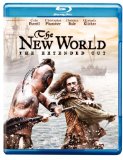| Reviews & Columns |
|
Reviews DVD TV on DVD Blu-ray 4K UHD International DVDs In Theaters Reviews by Studio Video Games Features Collector Series DVDs Easter Egg Database Interviews DVD Talk Radio Feature Articles Columns Anime Talk DVD Savant Horror DVDs The M.O.D. Squad Art House HD Talk Silent DVD
|
DVD Talk Forum |
|
|
| Resources |
|
DVD Price Search Customer Service #'s RCE Info Links |
|
Columns
|
|
|
New World: Extended Cut, The
New Line // Unrated // September 8, 2009
List Price: $28.99 [Buy now and save at Amazon]
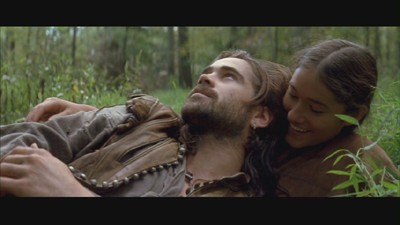 |
Days of Heaven director Terrence Malick has this tendency of releasing films only, oh, say every 10+ years or so. As he gets closer to finishing one of his projects, he edits the thing to death to make certain it flows just the way he wishes. The New World isn't only not an exception, it's a victim of sorts; before it made its theatrical debut sitting at about fifteen-minutes over two hours, a 150-minute cut made the rounds right before award season. Seemingly displeased with the end result, he withdrew the film from release and took it back to the cutting table. What resulted after these edits, to a finite point, is still an achievement of deliberate, visually awe-inspiring prose. Yet, the rumors of all this raw footage left on the cutting-room floor started circulating, and the scattered devout fans of The New World -- along with general fans of its director -- began salivating. Including yours truly.
In an interesting turn, New Line has released an "extended" cut of this beautiful piece of work, but it's not the same two-and-a-half hour cut that circulated during award season -- nor the oft-rumored multi-hour mystery cut. Here, Terrence Malick's The New World has been broadened to a hefty 172 minutes, just a shake underneath three hours. Is it one of those grand scale makeovers in the lineage of Kingdom of Heaven or Jet Li's Fearless? In so many words, no. Instead, it's the epitome of its descriptive title, as it mainly extends pre-existing scenes to even more sumptuous degrees of splendor. There's a few new sequences spliced into the film that spice up the narrative flow a bit, but the overall feel can better be summed up as taking the scenic route through already-gorgeous scenery. For most films, dumping more material into an already consciously-paced film would be a waste of time and resources; in the case of Malick's work -- especially the photography-bound The New World -- it's an effort that's far beyond welcome towards reinvigorating his initial vision.
The Film:
Everyone who has either read early American history books or seen the Disney animated film Pocahontas carries some grasp on the story at-hand: it's the tale focusing on the settlement of Jamestown, a rogue settler named John Smith (Colin Farrell, In Bruges), and the native woman Pocahontas (Q'orianka Kiltcher) who saved his life from certain execution by the other tribesmen. Malick's rendition of the semi historically-backed tale decides to push both ends of the possible spectrums for his telling, placing emphasis on both on the sensual bond between Smith and Pocahontas as well as the conflict-sparking communication barriers between the settlers and the Native Americans. His romantic notions get the best of him here, leading him down the romantic path through their blissful years together amid the tribe. But it's short lived, as Capt. Smith must return to his Jamestown post to tend the starving, desperate settlers rotting away in the Jamestown colony.
It's a story that, if told right, can be pegged down in a handful of sentences, yet it's in the cultural assimilation and the brevity in connecting with nature that push The New World's expansiveness towards soulful resonance -- both in Smith's grasping of native culture and Pocahontas' metamorphosis underneath the microscope of society. At first it establishes itself as an analysis on Smith, trekking him through the bones and filaments of tribal life. He's a man who has, in a sense, been reborn in Jamestown; Malick runs with this, treating his time with the natives as a "right place, right time" scenario that shapes him into something closer to the eclectic, spiritual model of Native American men. With his growing appreciation for wilderness existence, he also builds a grand appreciation for its children -- namely Pocahontas herself.
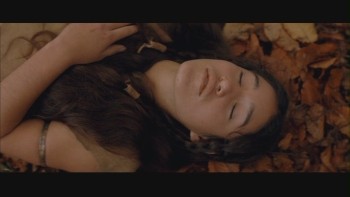 | 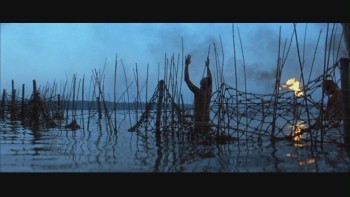 |
The New World takes its sweet time in guiding through Smith and Pocahontas' courtship, which is a signature move from visual artist Malick. He has a knack of keeping pace with his stories in a minimal-dialogue fashion that hitch a ride on the momentum of sumptuous cinematography. It's very difficult to keep a film going purely on landscape pans and subtle body-movement expository shots, yet Malick exploits his grasp on cinematic beauty to build the settlement's environment into a character of its own. Due in large part to immaculate, endlessly-researched production design surrounding the tribe's territory and Jamestown's crumbling fort-like structure, The New World's aesthetic prowess crafts en environment perfect for taking a gorgeous glimpse into the past.
Photographed on the Chicahominy River, a location very close to the original Jamestown, The New World takes the idea of untapped landscape beauty -- as well as the pristine, unblemished nature of the tribal people -- and amplifies it to astonishing proportions. Malick and Children of Men cinematographer Emmanuel Lubezki exhume organic browns and greens for their visual style, along with natural materials for everything from the boats to the clothing. There's beauty to be had around every bend of a creek and every sedentary wall, but it's a unique form of sumptuousness fashioned by ornate, realistic composition that beams with historical refinement.
Watching the performances in The New World reveals certain shifts in acting gravity, as it becomes a prime display of the weightlessness that blissful societal disconnect offers -- as well as a exposition on how venturing from nature can quickly wear its children down. Obviously, John Smith covers the "becoming one with nature" spectrum. I'm not sure what possessed Terrence Malick to cast the Minority Report and American Outlaws' rising star Colin Farrell, of all people, to play American pioneer John Smith, but he obviously saw a distinct dramatic quality that most didn't. Farrell's portrayal is surprisingly meditative, though his efforts work much better when he's keeping his mouth shut and tapping into unspoken emotion through body movements and gradual demeanor shifts. His innate masculinity intermingles skillfully with the prolific Native American cast, highlighted by the likes of Last of the Mohicans' Wes Studi and Free Willy's August Shellenberg. A large chunk of the visceral enjoyment to be had in The New World, similar to Gibson's Apocalypto, comes in glancing through the keyhole at an ancient culture. This dynamic provides a strong secondary foundation that helps to back up the emotionality and believability behind Capt. Smith and Pocahontas' relationship.
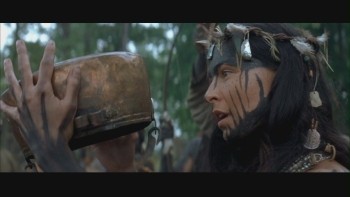 | 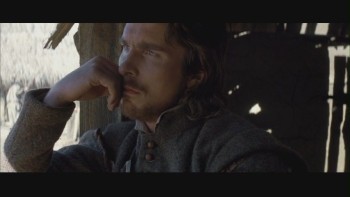 |
Of course, the real show-stealer is, as expected from early glimpses into The New World's trailers and marketing work, then-14-year-old Q'orianka Kiltcher, whose portrayal shatters all expectations one might have of a live-action version of Pocahontas. One or two scattered women stand out as visible entities in the tribe and in the Jamestown colony once it begins to boom, but in large part she's the only real feminine presence in the film -- and certainly the only one that we connect with. Kiltcher becomes, in turn, fascinating to watch as the near-ethereal embodiment of the Native American way of life, displaying properties about her physical projection that closely mirror deer-like grace and purity. It's actually pretty easy to buy into her and Farrell's bond as Smith and Pocahontas, something that becomes easier to see once it starts to crumble due to the colliding tensions between the tribesmen and settlers. Following her as she connects with a second Englishmen might've transitioned weakly during this stray from her native instincts, yet Kiltcher telegraphs this pivotal shift well as she plays off Christian Bale's intentionally indistinct performance as tobacco baron John Rolfe.
The New World transcends from a narrative-driven story into a poetic character study of sorts with these performances, one that relies heavily on illustrating the fading splendor of naturist purity -- along with the impact that the likes of gunpowder, gluttony, and ethnocentrism can have on its longevity. Terrence Malick discreetly makes this time pass before our eyes so that we might further absorb the primal interplay between characters, a struggle existing both on the native front and the Jamestown location that adds more brevity to the flow of the film than actual events occurring in its timeline. In that, the film becomes a beautiful allegorical divulgence of pure love instead of an event-based drama, which is easily its strongest asset. Malick's an inspiring visual lyricist, and if it takes him double-digit year spans to construct films with as much brevity and poise as The New World, then let's not rush the man between these gaps.
Theatrical vs. Extended Cut:
So, let's talk brass tacks here. How does the "Extended Cut" differ from the theatrical cut, aside from just being over a half-hour longer in minute count? The difference isn't earth-shattering, but it's certainly a welcome range of seamlessly-added earmarks. Just don't expect a narrative rearrangement on a grand scale, because The New World looks and feels just about the same as it does in it shorter concoction -- only with enhanced beauty, sensuousness, and poeticism in many, many shots.
Venturing a guess after side-by-side comparisons of the cuts, I'd say that around 40-50% of the new material is a range of minor extensions, like prolonging a few spans of Smith's first rowboat trip to the tribe's location, lengthening John Smith's play time with the tribesmen, or extending the tribe's approach to Jamestown during the winter. Since they're so effortlessly fused into the runtime, they're welcome additions that, surprisingly, never slow down the pace. They amount to more Malick-style capturing of landscapes that we already get lost in with the theatrical cut -- so, essentially, it's more of the same photography. And that's a good thing.
Yet, they've also been edited together a little differently in spots, along with re-engineered voiceovers and score accompaniment. It's hard to pinpoint exactly why, but the arrangement of a few scenes seem more fluid -- especially the new audio reworking, which engineers these new scenes to be seamless with the film's rhythm. There's also new implementation of Chapter Timecards that segment the film into distinct chapters. I'm still not certain how I feel about these, though they do add a dash of panache in preparing the viewer for the coming shots and in incorporating time-aware segmentation for ease in conveying time placement.
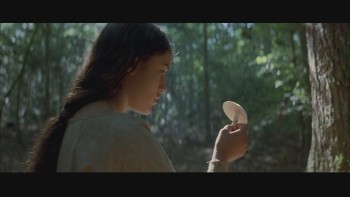 | 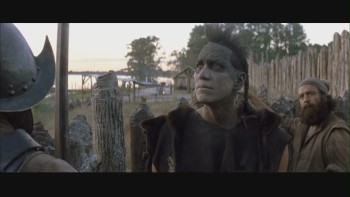 |
The other half of this new material doesn't affect the canon of the story, but it does add personality and depth of tone to The New World's rhythm. SPOILER ALERT --- There's an extended conversation between David Thelwis' snarky character and Christopher Plummer's Capt. Newport that further enhances the discomfort in sending Smith to the "savages", as well as further dynamic-enhancing scenes later on in the developing settlement. We're also working with a stretch of film that shows a tribesman intermingling with the Jamestown settlers in chummy fashion, some gorgeous new nature shots involving Pocahontas reconnecting with nature, as well as a potent conversation between Pocahontas and her uncle near the close of the film. She also receives a lot more face-time in the Jamestown settlement, certainly only edited down due to the film's length -- because the material is very good. Furthermore, we're allowed to see brief flashes of Pocahontas' mother weaving through tall grass, matched with some stretches of truly resonant mother-focused narration in subsequent areas. In fact, most of the substantial added footage revolves around enhancing Pocahontas' spiritual essence. --- END SPOILER ALERT.
Outside of that, the film's flow is largely similar to its theatrical distribution, just with extra padding in the editing to make it an even-more expansive and beautiful picture that rarely slows down in pace. To choose a preference between the two is tough, especially since they both reach the same destination by taking two equally-beautiful routes -- one in shorter time and the other with expanded leisurely enjoyment. However, the next journey taken into The New World will certainly be with this new Extended Cut. There's a lot of extra Malick goodness reinvigorated into this lengthier cut, including some astonishing nature visuals that really should NOT have been clipped from the final print. It takes longer to soak in this Extended Cut of The New World, but its elaborative beauty would be the suggested route if you're able to have patience with deliberately-paced historical drama accompanied by astonishing visual design.
The Blu-ray:
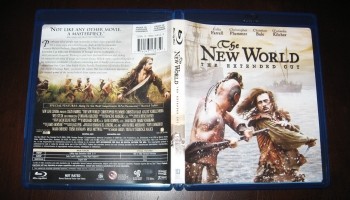 | 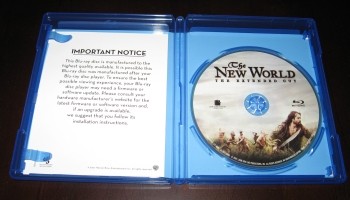 |
Finally, the folks at Warner Bros. / New Line have made The New World available in high-definition through this standard Blu-ray presentation. Design for the artwork and discart directly mirrors that of the standard-definition package for the film. Followers of the film will want to hold onto their Theatrical DVD for the original presentation, as the only cut available on this disc is the Extended Cut (172 minutes).
Video and Audio:
New Line's previous home video presentations of The New World have done a fairly strong job of maintaining a steady and attractive quality about the nature-heavy cinematography, but each of the film's visual treatments -- both the 135 minute theatrical and 172-minute Extended Cut -- have been crammed onto a single disc. As a result, both transfers have suffered from instances of enhanced sharpness issues and visible digital grain, though the images still looked befitting of the photography's sumptuousness. Thankfully, New Line's Blu-ray presentation offers a vastly more impressive experience, both as a significant improvement over previous presentations and as a stunning high-definition treatment. Packed into a full-bodied 2.39:1 VC-1 encode (topping 40mbps on a few occasions) that preserves the film's intended aspect ratio at 1080p, you're going to soak in a wealth of astonishing nature imagery filled with complex, colorful splendor -- all of which will cause a few jaws to drop with its quality.
Malick's eye for visual poetry is richly preserved here, in a color scheme that takes the palette from the Extended Cut DVD and reinvigorates it with a few splashes of natural, warm tones that went missing. Lush hues (especially an array of blistering greens) and sublime detail can be seen through countless blades of grass, texture against the native's faces smothered in make-up, and textural points like rope and burlap fabric express a notable level of intricacy. Nature elements like rushing water and tree canopies showcase graceful levels of movement that stay robust throughout, while also maintaining an air of realistic temperance -- such as emotional and physical coldness during the frigid wintry scenes, almost causing a few shivers at its capability to retain environmental demeanor. A couple of issues from the previous two transfers still peek out just a little, such as extremely fine edge enhancement and grain that hits a little harder than natural film structure. These points will appear very mild when poised against everything that this visual treatment gets right, all while maintain a very level-headed, film-like presence. To say the least, The New World boasts a winning high-definition image that comes very close to meeting the benchmark expectations set for such a visual work.
To keep speed with this smashing "new" image, New Line have also attached a Dolby TrueHD along with the Blu-ray. Multichannel activity was rife in the previous concoctions, but this level of clarity and enveloping ambiance easily bests these efforts. The mix sounds very similar, with chirping birds and crashing water coming at all the same points as the previous Dolby Digital legacy track. However, its freshness and capability to wrap us up in the natural setting vastly oversteps the track. Dialogue, whether the narration or the physical dialogue, flows through with the same level of heightened crispness as the rest of the track. Its aim is to make us feel as if we're rustling amid the fields with John and Pocahontas or tip-toeing through the settlements, and it succeeds admirably. The English TrueHD track happens to be the only audio track on the disc, while English subtitles for the deaf / hearing impaired stands alone in the subtitle department. It's worth pointing out that the bright white subtitles appear directly underneath the film's image instead of within the print, making it a bit of a pill for projector users.
Special Features:
Ten-Part Making-Of Documentary (1:21:35, SD VC-1)
Previously appearing on the Theatrical Cut DVD, this massive undertaking structurally hits all the bulletpoints of creating the film around their James City County, Virginia shooting locale. The expansiveness of this massive feature is incredible, taking the viewer directly into the assembly with effective behind-the-scenes footage and non-hokey interview pieces with the entire crew (production design Jack Fisk, art director David Crank, costume designer Jacqueline West, cinematographer Emmanuel Lubezki, and a world of others). It shows the process of the Native actors training and learning choreography for their roles, the reconstruction of Jamestown and the primitive campsites, the wealth of historians scrambling around to preserve accuracy, and the process of nailing down Pocahontas. "Extensive" barely covers it, as this footage -- presented in a somewhat raw, sober fashion -- covers and peeks under just about every nook and cranny of the film's conception.
With the Play All function, the documentary plays seamlessly throughout all ten parts. It's built in a way that the material can be seen either broken down or as a complete documentary without any lapses in understanding. Here's a Chapter Listing for the ten segments: Making the New World, Core Training, Finding Pocahontas, Recreating the Pawhotan, Along the Chickahoman River, Werowocomoco, Jamestown, The John Rolfe Plantation, The Battle, and England.
Two Trailers (VC-1) have also been made available -- both a teaser and a theatrical -- much to my delight, since the absence of even this simple feature from the Extended Cut DVD was aggravating.
Final Thoughts:
In its shorter edit and amid wishy-washy critical bludgeoning, The New World still knocked me aback with an awe-inspiring yet simple story bolted onto signature Terrence Malick visual composition. From aesthetic refinement to the ranged selection in actors, this rendition of Pocahontas' semi-historical rendezvous with John Smith took me by surprise. Yes, sweeping photography can certainly sucker in these film-loving eyes -- especially when it's poetic -- which probably plays into my affection for The New World. However, in its simple storytelling, poetic narration, and resounding primal beauty, it's a film that'll certainly hit me with each time through.
Now, that experience has extended from two-and-a-quarter hours to a near three-hour indulgence in The New World: Extended Cut. The additions are enough to further ignite my admiration for the work, yet not profound enough to change my observation on its beginning-to-conclusion impression. In other words, this is an even-more-scenic route worth taking, especially for Malick fans, but something that probably won't change your mind about its quality if you didn't favor it before. New Line's Blu-ray offers the film in the most attractive fashion possible, boasting extremely satisfying audio and video renderings of this gorgeous film -- and with the extras from the DVD this time, thankfully. Every breezy, sumptuous experience in watching The New World opens up different elements of beauty from nature, human interaction, and at times a combination of both, and this striking high-definition presentation heightens Malick's intended visceral punch to impressive degrees. Highly Recommended.
|
| Popular Reviews |
| Sponsored Links |
|
|
| Sponsored Links |
|
|
| Release List | Reviews | Shop | Newsletter | Forum | DVD Giveaways | Blu-Ray | Advertise |
|
Copyright 2024 DVDTalk.com All Rights Reserved. Legal Info, Privacy Policy, Terms of Use,
Manage Preferences,
Your Privacy Choices | |||||||









